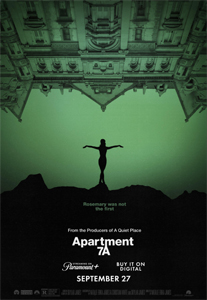With “Apartment 7A” (Paramount Plus), it’s all relative. It’s the least-bad “Rosemary’s Baby” spinoff (following a film sequel, a book sequel and a miniseries remake), but it’s not the best horror prequel about a pregnancy this year (edge to “The First Omen”). It’s enjoyable in a technical way, but never makes a strong case for its need to exist.
Fear of doing something different
It follows the lessons of Roman Polanski’s original, but too strictly for its own good. One thing about the 1968 classic that makes it mildly overlooked in horror annals is that it’s not all that scary; it’s psychological horror driven by Rosemary (Mia Farrow) being low-key terrorized by her neighbors.
“Apartment 7A” likewise doesn’t have a vibe of fear – unless you count director/co-writer Natalie Erika James’ fear of doing something daring. We follow “Rosemary” side character Terry Gionoffrio (sympathetic Julia Garner), a dancer who – if the NYC stage scene isn’t vicious enough already – is labeled “The One Who Fell” as she’s trying to bounce back from a broken ankle.
“Apartment 7A” (2024)
Director: Natalie Erika James
Writers: Skylar James (screenplay, story); Natalie Erika James, Christian White (screenplay); Ira Levin (“Rosemary’s Baby” novel)
Stars: Julia Garner, Dianne Wiest, Kevin McNally
A masterful (yet totally thankless) exercise in mimicry is pulled off by Dianne Wiest, perfectly copying Ruth Gordon’s iconic and idiosyncratic turn as nosy neighbor Minnie Castavet. Someone who has never seen “Rosemary’s Baby” might be riveted by the Terry-Minnie interplay, as “Apartment 7A” – while narratively a prequel – is essentially a remake. It hits so many of the same beats that source novel writer Ira Levin gets a screen credit.
Gifted with a free stay in Apartment 7G of the Bramford by the Castavets, Terry goes through the same experiences at the hands of the Minnie and Roman (Kevin McNally) that Rosemary will. We go deeper into Terry and her dance career dreams (she only has one scene in the original, spunkily played by Angela Dorian), and we meet Mrs. Gardenia (Tina Gray), the tenant of 7E before Rosemary and Guy move in.
‘Terry’s Baby’
James is Polanskian in the way she sticks with Terry’s point of view. As solid as Garner is, this decision means “Apartment 7A” can’t peel itself away from direct comparisons to “Rosemary’s Baby.” It also means the title is wrong, because 7A is the Castavets’ place. It might’ve been fun to see behind-the-scenes as they and their fellow Devil worshipers work through their scheme, although granted, there might not be a movie’s worth of material there.
“Apartment 7A” has flashes of its own identity. As we know from “Rosemary’s,” the cult uses black magic to injure their enemies, and the prequel lets us see it; a lead dancer’s tortured contortions are shocking. There’s little to quibble about regarding the reconstruction of the O.G. sets: I like the film’s subdued lighting and Sixties pastels, plus a neat new revelation about the Bramford’s architecture.

I might’ve liked more of a crossover into the “Rosemary’s” story; I’m mildly disappointed that we don’t get a reprise of the Rosemary-Terry conversation, but from Terry’s point of view. (While there are actors credited as Rosemary and Guy, it’s only for the most minimalist cameos possible.)
The biggest issue with “Apartment 7A” is not its competence, but rather its lack of verve to find its own identity – ironic considering its spitfire lead’s desire to stand out in the NYC dance scene. Terry is who you think she is; Minnie is even more who you think she is (to Wiest’s credit). The saga of this cult in the Bramford adds to the narrative only in length; it doesn’t add layers. What happens to Terry and Mrs. Gardenia is what you would assume.
It’s not poorly made, but in terms of story, character and themes, “Apartment 7A” is the very definition of unnecessary.

